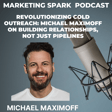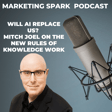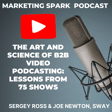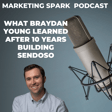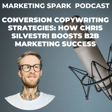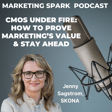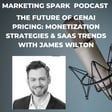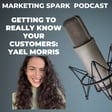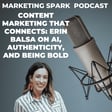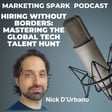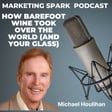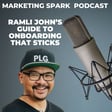Become a Creator today!Start creating today - Share your story with the world!
Start for free
00:00:00
00:00:01

The Art of Marketing Leadership: Emily Singer
In this episode of Marketing Spark, Emily Singer, VP and Head of Marketing at Drift, joins Mark Evans to discuss her journey and experiences in marketing leadership.
The conversation covers the evolution of Drift's brand messaging and the complexities of marketing in a rapidly changing business environment.
Emily talks about the importance of the CEO-marketing leader relationship and the collaborative dynamic within Drift's senior management team, particularly during challenging market conditions.
She shares insights on aligning marketing strategies with company goals, the impact of AI in marketing, and the importance of internal communication in driving success.
Transcript
Challenges for Senior Marketing Leaders
00:00:09
Speaker
Hi, I'm Mark Evans, and you're listening to Marketing Spark. Senior marketing leaders face many challenges in today's rapidly evolving business landscape. From balancing the pressure of delivering immediate results and maintaining a robust brand identity in a competitive market, the role of a marketing leader has never been more complex and demanding.
Marketing Leaders and CEOs
00:00:31
Speaker
One of the topics that I'm curious about is the relationship between marketing leaders and the senior management team, particularly the CEO.
00:00:39
Speaker
When the business landscape is challenging, I suspect the strength of the CEO marketing in the relationship is also challenging.
Emily Singer's Journey to VP of Marketing
00:00:48
Speaker
For more insight into this and other marketing topics, I'm excited to have Emily Singer, VP and Head of Marketing at Drift on Marketing Spark. Welcome to the show. Thanks, Mark. Great to be here.
00:01:00
Speaker
Why don't we start by sharing your journey to becoming the VP and head of marketing at Drift? It's a role that you've had since September, but you've been at Drift for about three years, right? Yes, about two and a half years now. And I joined Drift originally to lead and build out their communications and branding organization that involved, that evolved as the company continued to develop and shift strategies into a more comprehensive corporate marketing and customer marketing role.
00:01:30
Speaker
Yes more recently back in september our ceo ask me to step into the vice president marketing role to leave the entire marketing team which has been very exciting and humbling.
Evolving Drift's Brand and Messaging
00:01:42
Speaker
Before we talk about your relationship with the senior management team, can you talk about the job that you had as the communications branding person, trying to lead maybe, I don't know if you were reinventing the drift story or helping it evolve. How much of a challenge was that? And what were some of the key things to being successful in that engagement? One of the evolutions that even in my first interview with David Kenzel, who was our, one of our founders before I joined the company.
00:02:12
Speaker
was really the need to evolve and mature the drift story as we were continuing to move up market into the enterprise. So drift built, as you know, this incredibly scrappy and at some times controversial outspoken brand to really break into and invent the conversational marketing space.
00:02:33
Speaker
But the product offerings and the strategy continue to develop to become more mature and we were penetrating more enterprise customers. And so the brand needed to evolve and the messaging needed to evolve to really address those customers as we continue to move up market. So that was a lot of the charter.
00:02:51
Speaker
joining Drift and building out the communications and brand organization to align with
Leadership Dynamics with CEO Scott Ernst
00:02:56
Speaker
that strategy. Now, in your experience, I'm really interested in how the dynamic between you as the head of marketing and the CEO has evolved, especially at a time when market conditions are volatile. I've often heard about CMOs and marketing leaders seeking partnerships with the CEO and increasingly the CFO
00:03:19
Speaker
Discuss your relationship with Scott Ernst, Drift's CEO and Tim Redfern, Drift's CFO and COO. The relationship with Scott has been incredibly collaborative and successful in really partnering on the new Drift strategy, the new Drift messaging that we rolled out back in October and collaborating on how we wanted to evolve, not just the marketing organization, but the entire company.
00:03:47
Speaker
Scott has given all of us as the leadership team a charter of really acting what we call as team one, similar to what you would talk about in a parent-child relationship where the parents need to be very united and treat each other with mutual respect and alignment in order to foster the outcomes that they want to see in their children while not directly applicable in a familial sense
00:04:12
Speaker
He's really brought our entire leadership team together to take on this team one mindset of aligning and adopting all of what we call our strategic growth initiatives, which are five primary initiatives to lead the entire strategy for the year of really owning and taking extreme ownership
00:04:32
Speaker
one of our leadership principles across every function and not treating them as marketing owns the go to market one with sales product owns the product initiative.
00:04:43
Speaker
but that we all have buy-in and collaboration on how that works. And so he's really set the foundation for that. And then our relationship has developed from being his communications advisor into leaning in to lead all of marketing and the evolution of what that has looked like. And then Tim more recently joining us as CFO and now chief operating officer has also been a key stakeholder for me and my team. A couple of
00:05:11
Speaker
avenues to go down. One conceptually, team one sounds good. It sounds like a good business leadership concept, but practically and tactically, how does that happen in terms of building that relationship, maintaining great lines of communication, making sure that
00:05:30
Speaker
both parties are on the same page. What does the day to day look like in terms of making sure that dynamic is collaborative and at the same time challenging each other strategically and tactically? Can you talk about how that relationship is established and how you keep it going? I'll answer it in two different ways.
00:05:49
Speaker
One more tactically, the idea of Team One was explored and discussed as recently as November in an offsite that we had just north of Boston, where we came together as a more newly formed leadership team to really discuss how we wanted to operate as a team, what we wanted to hold ourselves accountable to, and the guiding principles for how we would lead the business.
00:06:12
Speaker
And so there was joint commitment as we exited that leadership off site to acting and adopting that team one mindset and what that looks like in practicality on a day to day and week to week basis will lead me to the second way that i'll answer the question and that is the regular touch points of.
00:06:31
Speaker
the points of collaboration be outside of our functional leadership areas. So every other week we have a two-hour leadership meeting together where we look at tier one, tier two, and tier three metrics across the business and share where things are going well, where they're not going well, challenges that we're facing, and then have very collaborative discussions on how we can solve challenges or how we can do more of the things that are working.
00:06:56
Speaker
And one of the guiding principles that we also aligned on was embracing those critical conversations and embracing productive conflict of being willing to go to the mat and disagree and commit when necessary and really have those open conversations within a safe space of our leadership team to then go out to the market, out to the team, whatever those audiences may be, out to the board, completely aligned on what that strategy is going to look like and what we need to go do.
Role of CFO in Marketing Decisions
00:07:25
Speaker
And then the second way that I'll answer that question related to more of the tactical application is, you know, I'm a communications.
00:07:32
Speaker
leader by background and trade. I think internal communications is often one of the most undervalued levers to use within an organization. And that is so critical for me as a marketing leader, but also for us as a leadership team to have those regular touch points and one-on-ones across all of the functional leaders to get really aligned on what we're sharing with our teams and when
00:07:57
Speaker
to cascade the most important points that need to get down to our frontline managers, to the individual contributors that make up our team. And we really err on the side of over communicating what our teams are focused on and what we're doing next.
00:08:12
Speaker
From the outside looking in, a lot of marketing decisions these days are made by committee. Obviously, in many organizations, the CEO is the final decision maker. But increasingly, the way that I've heard things is that the CFO plays a very big role in marketing decisions, particularly around ROI, bang for the buck, making sure that capital is spent as efficiently as possible.
00:08:40
Speaker
Is that something you've seen change during your tenure as a marketing leader? And is that something that's front and center at drift, as the company tries to make sure that everything it does from a marketing perspective, and obviously other parts of the business is as efficient and drives maximum ROI? What interactions would you have with your CFO in terms of making marketing decisions?
00:09:05
Speaker
We've all seen that naturally shift with the macroeconomic conditions that we've faced in the last year. And Drift has certainly not been immune to that. And I know you connected with Andrew, our former CRO, about this time last year, talking about how 2023 would be the year of measurement. And that has certainly carried its way into 2024. And so having that alignment with Tim as our CFO,
00:09:28
Speaker
to both really prioritize how we're making data decisions, data-driven decisions as a marketing team. So naturally, we're having the conversations around where that marketing spend is going to be allocated as we look at what we'll call fiscal year 2025, which starts in February for us.
00:09:46
Speaker
So we're really in the trenches as we speak on designing that marketing budget and having conversations of where we're making our investments. But where Scott has really been a strong leader and partner in this to elaborate on the connection with the CEO, but also in how we work with the CFO, is ensuring that those conversations between me and Tim or Tim and anyone else in the business is not happening in a silo. So how we're thinking about structuring our marketing
00:10:16
Speaker
our marketing budget. We're really looking at that through the lens of the entire organization and what we need to go do next year. And a very specific example of that is we have a quickly evolving product roadmap and strategy that will continue to evolve and roll out into next year. And so aligning our
00:10:37
Speaker
marketing programs, campaigns, and strategy all around from a thought leadership level, providing the air cover on market education and what that's going to look like, aligning campaigns with the same messaging that we're sharing as far as the product evolution as
00:10:52
Speaker
AI continues to impact our business and everyone else's and what that looks like. So naturally, to circle back to the original statement, I've definitely seen more CFO involvement as we get maniacal about how we're using more limited resources for maximum output. But I do think that's beyond just the CFO and the marketing team's responsibility and really goes back to that cross-functional senior leadership alignment.
Addressing Marketing Failures
00:11:19
Speaker
I wanted to circle back on your comment about having tough conversations and the ability to have them in a safe environment. Like a sports team, everyone's happy when an organization is doing well, but it's a different story when things don't go as well as expected.
00:11:39
Speaker
curious about how you and Drift's senior management team deal with marketing that doesn't perform. These are always tough conversations because marketing comes in with high expectations and they're optimistic about their campaigns and everything they're going to do, but some things are in your control and some things aren't. So what happens when a strategic initiative doesn't go as well as expected or campaigns fail to resonate? What do those discussions look like and what happens
00:12:09
Speaker
in terms of trying to get things back on track or doing something completely different? As far as when those conversations happen, I would address that first because I think that's a key piece back to my communications comment on having those conversations before it actually happens. So as we do get more
00:12:31
Speaker
detailed and focused on where marketing ROI is and how we're seeing that realized in the output of our work. We're having those conversations on a daily, weekly, monthly basis in those leadership touch points so that we can predict the best of our ability with the data that we have, where things are going well and where they aren't so that we can come together to hopefully remove whatever those obstacles are.
00:12:57
Speaker
But us, like any other marketing team and any other business, have certainly had failures or things that we've tried that haven't worked, and then coming back to why that didn't work. And the why, I think, is really the critical piece of that, is really understanding was it the seasonality, was it the messaging, was it the actual offer, whatever that may be, and really digging into the why so that we can make the best plan forward.
00:13:23
Speaker
And we were back to operating on principles that we've all aligned to. We focus on attacking the problem and not attacking each other. We try to assume good intent. And there are large challenges that marketing teams are all trying to solve. A more tactical example is marketing pipeline attribution to
00:13:42
Speaker
expansion or how adoption, retention and expansion all need to work together. And at what points is our marketing influencing that when we're partnering with the customer team and how we account for that and how we pull levers together to ensure that we're retaining our customers and helping them
Aligning Sales and Marketing Efforts
00:14:01
Speaker
get the most out of the drift platform together. And there's no easy answer for that. So we've all come from different perspectives from a product-led growth perspective on the product team, from the customer perspective on what they need to deliver those outcomes for customers from a marketing perspective of what's possible to be measured. And so some of those conversations are
00:14:22
Speaker
ongoing that we don't have a perfect solution for yet, but really leaning into what that challenge is and taking a collaborative extreme ownership approach to it. It sounds like a mature, if I can use that word, approach to marketing performance, but one of the realities is that there's a lot of pressure on senior marketing leaders to perform and increasingly a lot of them don't last very long if you look at
00:14:50
Speaker
some of the recent surveys average Fortune 500 CMO last 4.2 years and that's increasingly declining. What do you think? Why do you think that happens? Why do you think that market leaders have such short tenures? Is it that dynamic between the CEO and the CMO? Is it the way that
00:15:13
Speaker
companies approach success and failure? Is it simply the way of the world in terms of marketing leaders come and go? How do you explain that? And as important, what's your advice? And what's your personal view on making sure that you stay in the seat as long as possible?
00:15:29
Speaker
That is a loaded question, I would say. Where I've seen my own marketing leaders and turnover happen is usually from lack of alignment with the sales team more than anything, and then ultimately the CEO. That's my personal experience and observation of where that's happened.
00:15:45
Speaker
As far as why that is, I think I'd be remiss to also bring up that marketing is an area of business executive roles that women occupy more frequently than men. And I do think that there is some element of that, but that could be a whole other wormhole there. So I'll leave that where it lays. I think between that and then getting really clear alignment on how you approach business results.
00:16:12
Speaker
keep repeating the same sentiment. But on the note of communication and on the note of extreme ownership together, our sales leader Lee and I tell both of our teams that
00:16:25
Speaker
These are owned and shared metrics. We do not break down pipeline currently by attribution. We were spending way too much time in the last fiscal year trying to assign credit, for lack of a better word, to where sales was contributing, where marketing was contributing. That's not the world that we're in right now, and we need to focus on ultimately bookings and how that's going to influence AR together.
00:16:51
Speaker
and think about all of the metrics that lead to that point. And so it's working together to ensure that we have the pipeline coverage to get us ultimately to those top line goals and focusing less on credit and attribution and more on what's working and how we're working together. Because I think anyone that's been in a sales and marketing seat understands that that line is not always clear.
00:17:15
Speaker
It may be the sales team that's initiating it, but sharing key marketing assets that helped with the education that led to that sale. It may be marketing that initially invited someone to attend a field event, but it's ultimately that salesperson that did all of the legwork to close that deal. And we see cases and cases of that. So we really take the approach of the one pipeline, one team. In many organizations, marketing is sales and sales is marketing. The lines are completely blurred. I do want to take a step back and
00:17:44
Speaker
get a little more color on the comment that you made that a lot of CMOs don't last very long because there's a misalignment between marketing and sales. What do you mean by that? What does that look like in the wild?
00:18:00
Speaker
As an easy example in my career and observation was at a time of COVID and when that was shifting the landscape in an unexpected way. And we saw a quarter in my former company, a quarter where performance did dip as we were all responding to a current pandemic and the pointing of fingers in that state.
00:18:22
Speaker
of what marketing could or could not contribute when sales performance fell. And then I won't comment on the semantics of how those interpersonal relationships happen, but when you're in a state, it's easy when things are going well or even when things are going okay. But in times of crisis or in times of the unknown or uncertainty, you have to have that underlying trust that's there.
00:18:48
Speaker
to be able to weather that storm. And so I think it's when you don't have that trust, even in the times where things are going well or okay, then when things do start to break down, that's identified and ultimately leads to a change there.
Marketing Attribution Challenges
00:19:05
Speaker
I also want to pick up on your comment about attribution.
00:19:10
Speaker
One of the realities of the marketing mix is that attribution is increasingly difficult if not impossible these days and that some marketing activity can be quantified and some can't. There are things that don't have to be quantified because it's just part of the marketing mix and it lays the foundation for good marketing and sales and some things that you do want to lean into data.
00:19:36
Speaker
And you do want to quantify and see if what the impact of that is within the drift world and marketing in general, what's that balancing act between qualitative and quantitative? And how do you build a marketing package or a marketing engine that that embraces both and allows different types of activities to happen in different ways?
00:20:01
Speaker
We would all love to have a silver bullet on exactly how that works. And you're absolutely right. There is a balancing act and a dance on how you do that. And I would come back to my earlier comment on
00:20:14
Speaker
really thinking about the marketing investments and attribution and alignment of our goals and how we're going to measure up against the broader backdrop of what is our goal and strategy as a company. I mentioned earlier the evolution of our product roadmap and focusing on the key product launches that we have coming up this year and providing that air cover on thought leadership. Some of the things we'll be launching this year are disrupting
00:20:41
Speaker
ourselves disrupting what the conversational marketing category looks like. We as our own marketing organization, as we primarily sell to marketers, have to evolve ourselves and shift in this new version and react and hopefully lead through this AI change that we're all seeing. But to get back to your specific question, that needs to inform how we make those decisions.
00:21:07
Speaker
As an example, I mentioned you talked to Andrew about a year ago around the same time, and he was absolutely spot on that we decreased investments in a lot of brand events, et cetera, that are less dollar in, dollar out.
Brand Investment Strategy
00:21:20
Speaker
And that happened in 2023.
00:21:23
Speaker
Our strategy heading into the next year without getting into the specifics of it, at a macro level, we're looking at about a 25% brand spend and a 75% demand spend as our breakdown. And that 25% brand spend is going to require additional communication, additional education on how those programs are paying off.
00:21:45
Speaker
We need to go tell the story in the market about how marketing is going to change when ABM is no longer the gold standard of personalization, possibly segmentation goes away as all of this automation and the playbooks that are
00:22:01
Speaker
that we originally built as part of best practices with conversational marketing are now becoming bionic and what that looks like for personalization. So really bringing the market and our key audiences along on that journey is going to require the air cover that is not just selling drift or high ROI programs of dollar in, dollar out. And I
00:22:23
Speaker
Frequently use Simon Sinek's analogy of going to the gym and then lifting up your shirt and expecting to see abs on one day. Brand is very much like that. You have to commit to the long-term repetitive consistency.
00:22:38
Speaker
And so being able to communicate that effectively internally and get the buy-in from my fellow senior leaders, that is important and this is how it's going to pay off. And then also offer more quantifiable, back to your question about the CFO, outputs of that. Are our EAs increasing? Is our organic site traffic increasing?
00:22:58
Speaker
what is Google analytics telling us as just simple examples of more of that top of funnel indicators that tell us that the brand awareness air cover and thought leadership is paying off for us. That's interesting. The brand and brand strategy may have been top, not top of mind for a lot of companies in 2023. The focus, maybe the obsession was with leads and sales. And I think one of the challenges you mentioned is quantifying the impact of
00:23:24
Speaker
of brand and brand investments can be difficult. Do you think that as a marketing leader that it's hard to
00:23:34
Speaker
educate other people because they just don't have the knowledge and the insight into brand strategy? Or is it that they're more focused on the direct correlation between if I spend X, Y is going to happen? Or is it maybe a lack of patience when it comes to brand building? What do you see as the biggest challenges when you're trying to wave the flag for brand strategy inside any organization?
00:23:59
Speaker
The simple answer is absolutely the measurement piece. I think it's a combination as far as what you asked, whether it's the education piece or the being able to measure. When there's either lack of education or just lack of buy-in, it always comes back to the measurement of how do we know that is working? And that is the largest challenge of being able to do that. I have had the fortune in this role at Drift.
00:24:28
Speaker
having joined the company when David Consell was still our CEO and then transitioning to Scott's leadership of having both very supportive CEOs that understand marketing and also have seen the value of branding in the business performance.
00:24:44
Speaker
So I would say I'm further up that hill pushing the boulder than other marketing leaders are perhaps but that's also critical to have alignment not just with the CEO but across the entire team and be able to communicate and demonstrate.
Integrating AI into Marketing Strategies
00:25:00
Speaker
Qualitatively through things like customer feedback. Rather than quantitative feedback when that when those exact attributable dollar in dollar out metrics aren't available.
00:25:14
Speaker
You've touched upon AI throughout the conversation, and it would be remiss if I didn't ask you about AI within your world. According to Drift's third annual State of Marketing AI report with the Marketing AI Institute, 32% of marketers and business leaders surveyed said that their CMOs either partially or fully own AI at their organizations. So what is your relationship with AI, and what's been the journey so far to integrate AI into how
00:25:44
Speaker
your team does marketing strategically and tactically? I will address the journey piece of it first. Drift has really been a pioneer in conversational AI and AI in the marketing space for much longer than many of the vendors in today's time want to claim. We have the benefit from a product strategy of really having that integrated already into our product, and that's only going to continue to evolve.
00:26:14
Speaker
As far as the marketing team is concerned and leadership in driving that AI transformation within drift, but also externally really brings together two
00:26:24
Speaker
Two things for me. One is actually using our own platform. So we call ourselves Org1, which just refers to drift on drift. We feel very strongly about being authentic and practicing what we preach. And so using the drift buyer engagement platform to see the outcomes that we preach to our customers. And that means adopting these new products like Bionic Chatbots that are, as I mentioned earlier, disrupting ourselves.
00:26:54
Speaker
if we have hundreds of playbooks built that have been built since Drift's inception and now we're moving to a strategy of how do we narrow that down to one playbook, zero playbooks, if they're all becoming bionic and shifting into that really personalized approach using our own platform and practicing what we preach.
00:27:14
Speaker
And then equally looking at ourselves internally, Scott attended one of my monthly, I'm sorry, weekly marketing huddles with the entire team. And we didn't ask me anything with him. And somebody on my team asked him specifically, can you tell us candidly one thing that you think marketing could be doing better or is an opportunity for us in the business?
00:27:34
Speaker
And his response to that was marketing has already been adopting AI in the form of our platform. We also use tools like with our partners with Jasper chat, GPT, et cetera, within our own, within our own organizations. But he has really asked us and challenged us.
00:27:52
Speaker
to based on those report findings of the CMO and CEO really driving this transformation to asking the entire marketing team to take more of a leadership role in the organization of demonstrating what that looks like. Can we come back to our all hands meetings and share out the results that we're seeing the best AI tools that we're incorporating and how we're working with those alongside with our own platform to really adopt AI internally.
Marketing Trends for 2024
00:28:21
Speaker
A lot of organizations would be interested in your take on the best AI tools out there. I asked you some challenging questions, some tough questions. Let me ask you a different type of question. When you look into your crystal ball, what do you see as some of the key marketing trends in 2024 and how is Drift's marketing approach different from last year?
00:28:43
Speaker
As far as the trend piece of it goes, I all start on the same topic that we're on. And that really is that I think CMOs have the CMOs and marketing leaders and marketing teams in general have the opportunity to be the change agents within their own organizations as far as AI is concerned.
00:29:00
Speaker
We've seen the stat, I think from Gartner, the 70% of a buyer's decision and research has already been done by the time they're engaging with a brand. And so that leaves only 30% of the interactions with sales. So marketing and that number is only continuing to grow.
00:29:16
Speaker
So marketing is increasingly owning more of the buyer journey. And so that means we have the opportunity to really influence what that's going to look like and leverage AI in the transformation of marketing. That'll take me to additional predictions. I, we're foreseeing things like account-based marketing starting to become not the gold standard of personalization as these AI capabilities emerge.
00:29:43
Speaker
We're really talking to our customers and in our own Drift deployment of one-to-one personalization and understanding what that individual buyer, not the account or the company, what they actually need at that one-to-one level and being able to deliver that. And we've seen Drift was founded on the premise of
00:30:05
Speaker
Seeing the convergence of B2C and B2B buyer expectations come closer and closer together that has only continued but we know from Merkle data and other sources that.
00:30:17
Speaker
Largely vendors have continued to not meet buyer expectations. And our take on that is it's because of the lack of scale when you don't have human capital to address every single one of your customers, every single one of your prospects on a one-to-one level. Now we're seeing AI step in and actually make that possible. And so we need to anticipate both from a product strategy, but also as our own enterprise company, how to anticipate that shift in marketing and what that's going to look like.
Connect with Emily and Mark
00:30:48
Speaker
Final question, where can people learn more about you? And Drifter's obvious, but where can they learn more about you? Learning more about me specifically, LinkedIn would be the best resource for that, or I have the same handle on every social media, emccsinger, which I believe is also my LinkedIn.
00:31:07
Speaker
And yes, Drift is more obvious, but drift.com and I would say the most exciting thing to check out right now is our Bionic chatbot demo where you can type in your own company website and see what I'm talking about of how this is going to shift marketing and building Bionic playbooks for yourself.
00:31:24
Speaker
Thanks, Emily, for the great insight into all things marketing, including that interesting relationship between the head of marketing and the senior management team. And thanks to everybody for listening to another episode of Marketing Spark. If you enjoyed the conversation, rate it and subscribe via Apple podcast, Spotify, or your favorite podcast app and share via social media.
00:31:45
Speaker
If you're a B2B or a SaaS company looking for more sales and leads, but struggling to do marketing that makes an impact, we should talk. I work as a fractional CMO and strategic advisor. My services include a 90 day marketing sprint that combines strategy and tactical execution to move the needle quickly. You can reach out to me via email, mark at markevans.ca or connect with me on LinkedIn. I'll talk to you soon.


